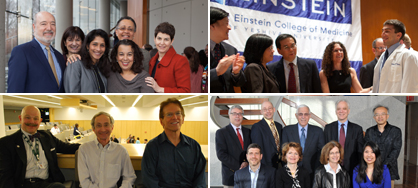
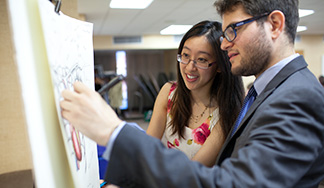
Encouraging Kids by Doing
Einstein Buddies: Learning through Observing and Assisting
A group of first- and second-year medical students entered the Van Etten building lobby recently to find it had been taken over by pint-sized superheroes, monsters, bumble bees and angels.
Dr. Carol Terilli, supervisor of physical therapy at the Children's Evaluation and Rehabilitation Center (CERC), directed the medical students to various stations situated throughout the crowded lobby, where costumed children jumped in a bouncy castle, tossed bean bags and made crafty creations.
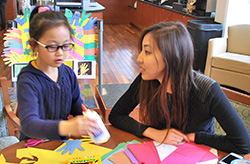
Vivy Tran and a child participant doing crafts as part of an Earth Week activity"The idea behind each of the activities is participation and independence," said Dr. Terilli.
A cookie-decorating activity exemplified this premise, in which children worked together, interacting with one another while using motor and sensory skills to creatively decorate cookies. Some of the children had disabilities and are clients at CERC.
"The purpose of our occupational and physical therapy interventions is to enable all children, regardless of their disability, the opportunity to participate in all life activities—including these fun party activities—with their families and peers," noted Dr. Elizabeth Ridgway, CERC occupational therapy supervisor. "Collaborating with the Einstein Buddies project has helped broaden the opportunities for our clients, families and therapists, as well as for the medical students, as we create experiences together that enhance learning and participation for all."
While the youngsters decorated cookies, colored monster masks with magic markers or designed spider webs made from Popsicle sticks and string, the medical students encouraged them and also did some coloring and painting as well.
That's the point of Einstein Buddies, a community service project in which members work with CERC staff during treatment sessions and special events attended by children receiving center services. As "Buddies," the students aren't there to instruct or teach the young patients; they are there to observe and to take part.
The project is among those within Einstein's Community Action Network and receives support and guidance from staff of the Community Based Service Learning Program (CBSL).
Offering Insight and Inspiration
Einstein Buddies got its start when students David Hark and Kyle Kelson approached Dr. Robert Marion, then director of CERC, with the idea of providing medical students with learning experiences involving families and patients in the developmental disabilities community at CERC. The program was developed collaboratively with Drs. Terilli and Ridgway, and was constructed to allow student volunteers to attend physical and occupational therapy sessions with young patients, to observe the therapy experience from the child's point of view. Now in its third year, participation among students has grown to 15 regular volunteers.
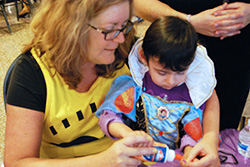
Elizabeth Ridgway with a youngster making a spider web from pipe cleanersEvery month, Buddies sign up to attend therapy sessions where they help motivate and encourage the children by participating in that day's therapy activity. They become a model for the children, demonstrating how to complete tasks and overcome challenges.
"The Buddies are able to model strategies for learning for the kids," explained Dr. Terilli. "It's helpful for them to see someone else learning, making mistakes and correcting them. And sometimes the patients are able to offer cues to the Buddies, which develops their leadership and confidence."
Learning by Doing
One therapy session that's popular among the Einstein Buddies is karate. Learning karate with the children has been one of our most rewarding experiences, concurred group leaders Ben Puliafito and Vivy Tran, the only second-year students currently involved with Einstein Buddies.
"I didn't know karate, so it was fun to learn with them," added Ms. Tran. "We do it together."
Mr. Puliafito, who has taken part in karate since last year observed, "Within a few months, the kids from the first sessions were actually teaching new kids what to do. You see real improvements in the kids' coordination, and balance—even from the beginning to the end of a single session."
Gaining Professional Insights
Experiencing therapy from the perspective of a child with a disability is helpful to informing some students about their possible career choices. Mr. Puliafito is considering both pediatrics and neurology among disciplines that interest him, while it was Ms. Tran's love of working with kids that inspired her to attend medical school.
"We're able to attend all kinds of therapy sessions, from handwriting exercises that help kids work on motor skills and dexterity, to karate and problem-solving workshops, where the kids are challenged to process information and work through steps toward an attainable goal," said Ms. Tran. "It offers a nice break from studying your anatomy textbook."
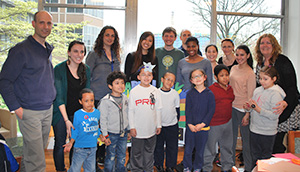
Einstein Buddies with CERC staff members and children who took part in their Earth Week activities"It's a satisfying part of my week that lets me escape the tedium of medical school for a while. It's playful and fun," said Mr. Puliafito.
A Mutually Beneficial Experience
"Having the medical students in the therapy sessions is also about motivating the children," said Dr. Terilli, who has worked at CERC for 25 years. "Many developmental disabilities require long-term care and services. After a few years of working together the kids are happy to say, ‘Oh who's that?' And they enjoy the camaraderie of learning playfully with their ‘Buddies'."
"A community project like Einstein Buddies allows medical students to understand patients in their world—something which will help when they become doctors," said Dr. Maria Marzan, director of Einstein's CBSL. "It provides an invaluable perspective, because they get to see and experience the patient's side of things up close and personal."
"We learn so much from our involvement with CERC and their clients," said Ms. Tran. Recalling an Earth Day activity from the spring, she described how some of the children decided to alter things a little. "After making flowers out of construction paper and pipe cleaners, some of them began to hang their flowers around the Einstein campus, attaching them to doors and poles. They called it ‘planting flowers' and it was fun to see their idea blossom and how others responded to their creativity."
She paused a moment, smiling at the recollection. "When I'm with them, they constantly inspire me."
Posted on: Friday, January 16, 2015


